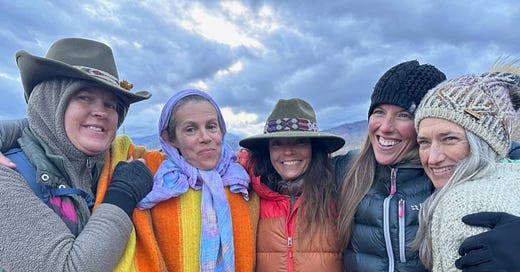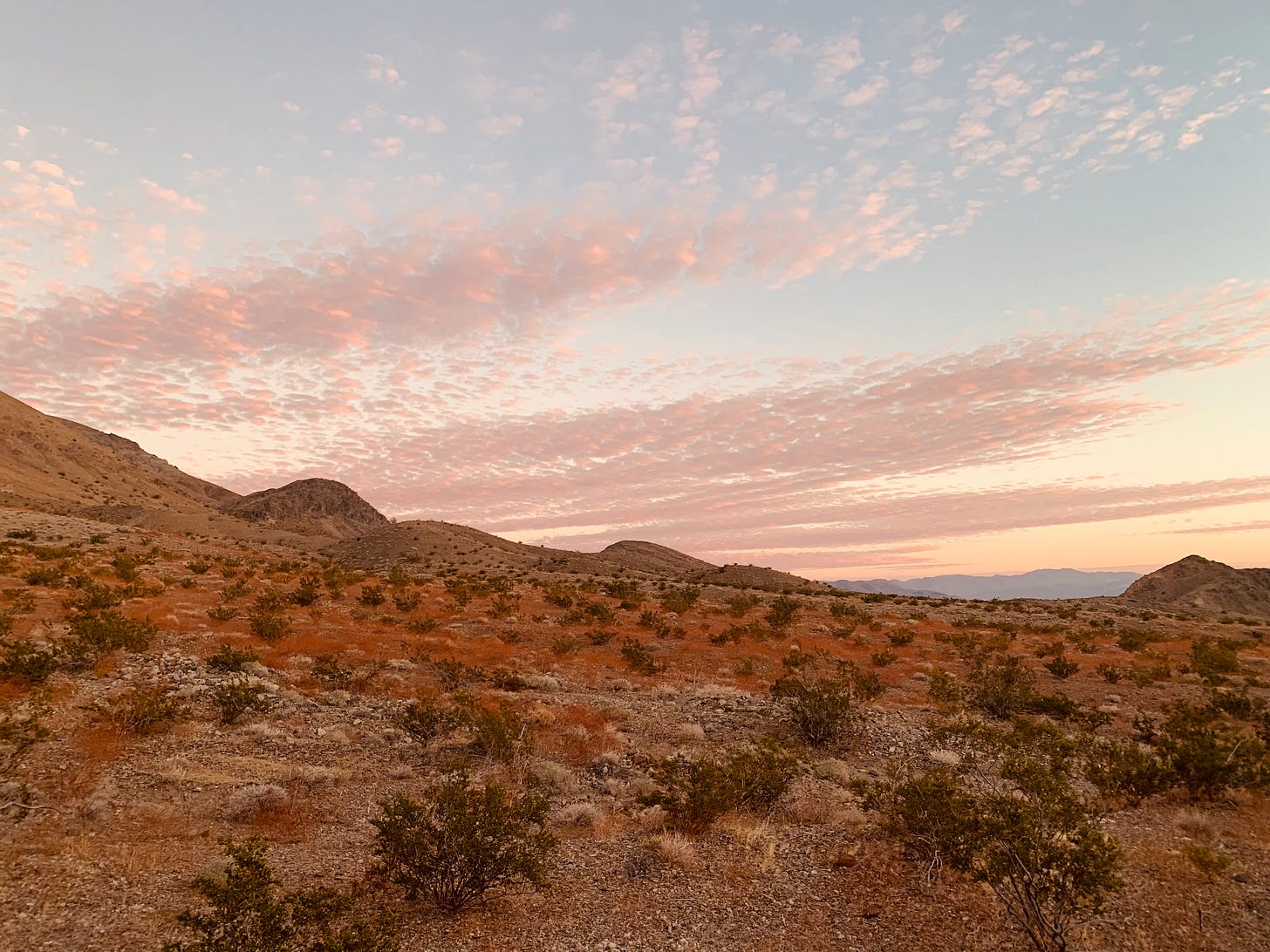A bit over a year ago, I participated in a 10-day women’s Vision Fast in the Eastern Sierras, near the Payahuunadü (the Owens Valley) in California. An intentional wilderness rite of passage offered by The School of Lost Borders, the program is grounded in ancient indigenous rituals designed to mark, celebrate, and make sense of the cycles of nature and spirals of death and rebirth. These practices offer us an intentional initiation into any number of important lifetime transitions, identity shifts, and developmental stages and help us place them in meaningful context within our lives, communities, and place on this earth.
Much of my writing in The Splash focuses on our societal and individual disconnect from nature, and by definition then, from ourselves and each other. I write of what we might do to heal these relationships and of the important wisdom available to us when we are able to be in connection with the natural world. From this perspective, I was curious what participating in an organized ritual focused on right relationship to the natural world and designed to mark transitions and open portals to deeper knowing might mean for me.
Ancient cultures around the world have practiced ceremonies and rites of passage to mark key life transitions—birth, naming, adulthood, marriage, creating life, elderhood, death, rebirth—for tens of thousands of years. These rituals are designed to initiate participants into new life stages, delineate roles and responsibilities, and create coherence for individuals and their communities. In doing so, they help provide meaning and context in a human life, model healthy relating, and maintain societal order.
Often these rites center around communing with the more than human world1—the animals, mountains, waters, rocks, soils, trees, insects, all of them—so we can “decenter ourselves enough to see the world as it truly is”2. So we may witness, feel, and integrate the depth of interdependence that weaves all the world together—to know that as the tall cedar exhales, we inhale; as the water tumbles, the salmon are gifted oxygen; as the moon shines, baby turtles navigate from sandy nest to sea. So we remember that if we become too self-absorbed, too lacking in awareness, we will perish.
By way of illustration, the Apache honor a girl’s coming of age with the Sunrise Dance, a four-day ceremony filled with drumming, traditional foods, dancing, and the blessings of a Medicine Man. During this ritual, a girl temporarily becomes Changing Woman, a mythological figure who is First Lady and mother to her people, and represents transformation, the rebalancing of male and female energies, and the growth of women into womanhood. She is gifted spiritual teachings and coached by a Medicine Woman on the elements of the ritual, and held by her community with song, dance, food, skill-building and hard work. Dressed as White Painted Woman, the girl dances for hours each day in preparation for the final evening when she will dance continuously until dawn in a test of stamina. Her community supports her by singing “about everything—the cattle hide she dances on, the teepee poles, the rattles, the mountains, the sky and all of the animals—on land, under the ground, in the air,” says ceremonial chanter, Byron Blake. While difficult to articulate, Apache women report being changed by the ceremony, bestowed with a sense of responsibility for themselves and their families, a sense of “how to live,” shares elder Donalyn Torres.3
The Sioux conduct Inípi (Lakota term meaning ‘to live again’) ceremonies—or sweat lodges—as a rite of purification. The dome-shaped Inípi lodge is constructed of sixteen willow poles and covered with canvas or hide and is thought to symbolize Uŋčí Makȟá, or Mother Earth’s, womb. Before the ceremony, a leader burns sage or sweetgrass inside the lodge and offers prayers and intentions to purify the structure. Participants enter the lodge, sit on sacred sage, and pass around a ceremonial pipe while heated rocks are honored and placed into a center fireplace. Water is poured on the rocks to create steam to purify the occupants. During the ceremony, the door to the lodge is opened four times in honor of the four ages described by the Sacred White Buffalo Calf Woman (who changed color, transitioning from a black buffalo to brown, then red, then white, representing the four ages of creation, the last of which—the arrival of the white buffalo—heralds a time of great change and a chance for humanity to reconnect with nature and each other). When the door opens for the fourth time, the participants emerge from the lodge, leaving behind all impurities.
While our culture retains some connection to rites of passage—celebrating weddings, birthday, graduations, or marking first experiences—a first kiss, registering and voting, taking a gap year—these practices generally lack sacred context and most often fail to meet the deeper transformational or developmental needs of a people. This leaves us with a blurred sense of identity, feelings of disconnectedness, difficulty navigating major life transitions, increased anxiety, and a lack of understanding of the responsibilities associated with life stage. In effect, we are a culture full of uninitiated adults “unable to operate with maturity, wisdom, and an ethic of service towards others and the Earth”4. Today we are witnessing these effects writ large as our democracy falls prey to the cumulative actions of generations of uninitiated adults lacking maturity, wisdom and any sense of service towards others and the Earth.
Like the Apache women, it’s hard for me to articulate what exactly happened during the Vision Fast. I could tell you the sketches of the program—about the months of preparation and intention setting we did prior to arrival. About the time we spent in severance, focused on leaving behind day-to-day life and preparing for the fast with questions like: Who you are? What do you need to leave behind? Where are you going? About sealing this all with an intention.
I could tell you about the second phase, the threshold—or liminal state (where liminal means transitional or betwixt and between)—where we stepped across the threshold into the wilds to spend four days and nights alone with no food and plenty of water. I could tell you about the final phase, incorporation, where we returned from the wilds to reunite with our group, share our stories, and integrate our experiences before returning to offer our gifts to our communities. I could tell you how the guides mirrored our stories, our struggles, our revelations so we could better see and feel them for ourselves.
But, really, none of the details of the happening are what matters. What’s more significant is the question of whether and how I’ve been changed by the ceremony. The answer to this, too, was at first elusive. Many have described these rites as prophetic and life-changing, but for me, the experience was…subtle. So subtle that the question began creeping in as a doubt: Was anything happening? Was this challenging enough? Was I missing something? But eventually the doubt receded when, halfway through the program, I understood that the subtlety was the answer.
Except for one of the guides, I was the oldest participant in the group. A couple days in, after we’d shared our intentions for the fast, the guides suggested to me that I was journeying into elderhood. This didn’t land all that easily for me. I’d never seen myself this way—I felt young, vibrant, alive. I’d lived a life that doesn’t easily fit into any boxes, let alone those I might have envisioned befitting of the label elder. I didn’t have children, I didn’t have a traditional job, I didn’t live a conventional life, and as a result, I’d experienced decades of fitting in wherever and however I wanted, seemingly escaping a rash of societal labels.
Yet, over time, as my place in the group began to take shape, I warmed to the idea. The evidence was there: Unintentionally, I’d chosen a solo rest spot that was the furthest and highest point away from camp. I was perched atop a peak, surveying the landscape, holding space. During my solo time, I was fully at ease, comfortable sleeping beneath the stars without a tent, unconcerned for my physical safety—it was warm and calm, there were no predators, the landscape was wide open, I could see for miles. I understood that while others may have been performing deeply witchy ceremonies, burning and burying past hurts and traumas, reckoning with skeletons, forgiving themselves and others, claiming their gifts and powers, I was doing none of it. Not because I didn’t recognize the value, not because I was inhibited, not because I was avoidant, but rather—I had already done so much of it. I had wailed my traumas into a dark chasm to middle earth beneath a pyramid in Teotihuacan; leaked tears and snot onto crystals; processed losses and betrayals; found and lost and reclaimed love; broken out of societal and my own mental prisons. I had moved well beyond the angst and questioning that punctuates so much of what it means to be a woman in this society. I was calm, grounded, present, aware, and grateful. That was it.
And, from that perch, I spent four days watching the desert breathe—the powerful little lizards dancing their dances; the delicate songbirds singing their hearts out; the insects arranging flotsam into shelters. I read messages in the clouds; imagined an ancient sea depositing drifty sand dunes on the ocean floor, now shown to me as undulating surfaces on chunks of sandstone. I listened for crow wisdom, collected dried flowers and arranged them on an altar. I prostrated myself, naked, to Father Sun, absorbing his warmth. I watched over my younger buddy, nestled in the canyon below, leaving her love notes and flowers at our check-in spot each day. Holding space for her from afar while imaging she was processing the way I would have been processing several decades prior.
I understood. I understood I was embodying elder energy, sitting in calm knowingness. I had nothing to prove, nothing lacking, nothing to process. I was here to hold space and be a guiding light for the amazing women coming up behind me. I was being experienced by these women as powerful, grounded, wise, and they told me so. During our last several days together, a few of them dubbed me Elder Babe and it stuck. That was a label I could get behind. (And to be fair, my ego loved it.) So it was. I took it on, let it soak in. Started to find comfort with the audacious proclamation I had made to the Universe, I am a powerful, creative elder (babe), bringing beauty to the world. And, here I am today, bringing my messages to you.
Abram, D. 1997. Spell of the sensuous. Vintage Books-Random House, New York, New York, USA.
Perluss, Betsy, PhD. November 23, 2021. Ancestor Preparation: On Becoming A Good Dead Person.
Benanav, Michael. September 6, 2023. An Apache ceremony for the ages. Searchlight New Mexico.
Chandler, Jasmine. November 29, 2022. What Is Rites Of Passage And Why Is It Important?








Wendy: This is a really, really, really great piece of writing. I'll let others more qualified speak to the spiritual dimensions of your experience, I'll just say, writer-to-writer, I know how hard it is to write about one's spiritual passage with that kind of intimacy and objectivity, clarity and mystery. I know how important it is to be able to blend important background context with personal experience and to do it in a way that, rather than thinking, "I wish I could do what she did" the reader will think/feel, "I'm excited about having the opportunity to do this kind of intense work in my own way in my own time.
Best wishes for your ongoing "elder" journey.
This resonates with me! I can see that I've been rejecting the elder title when others have seen this in me. Thank you for articulating this so well.